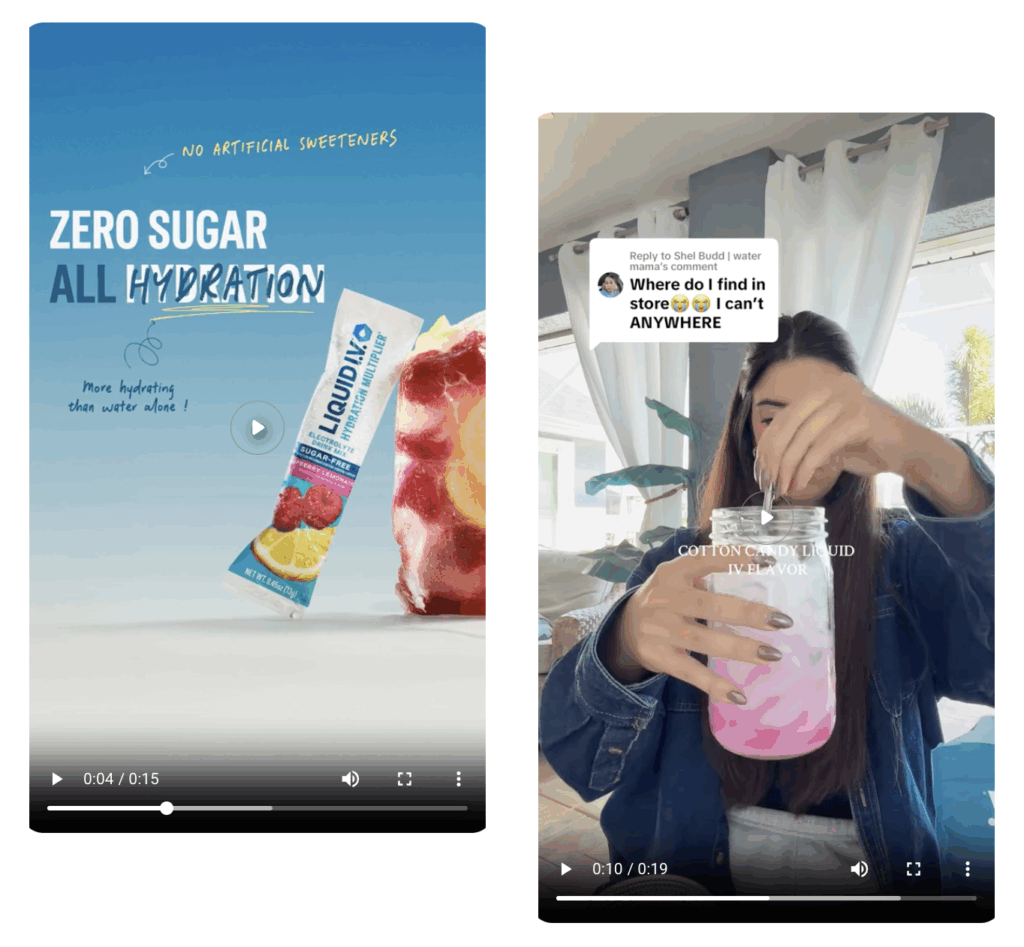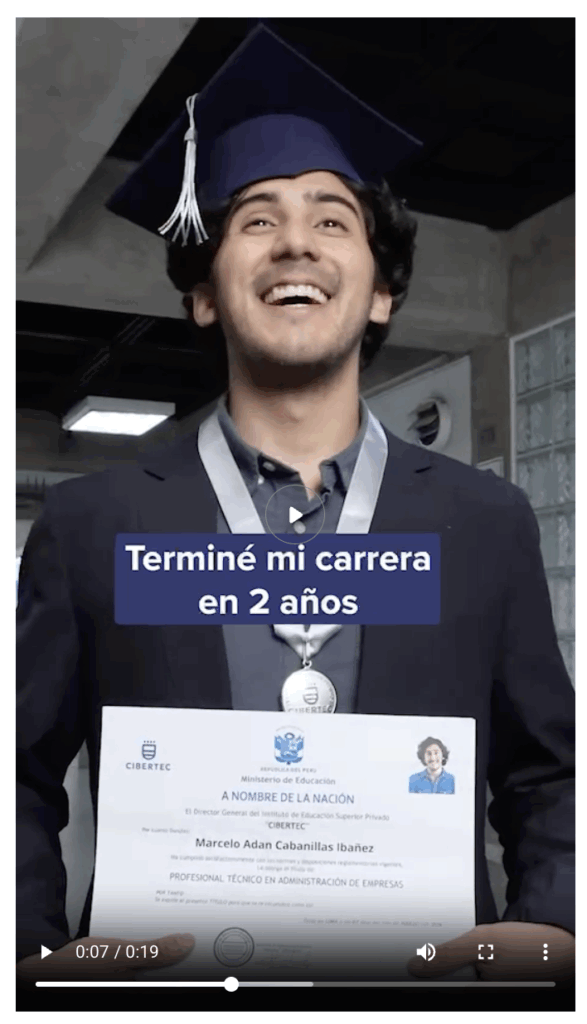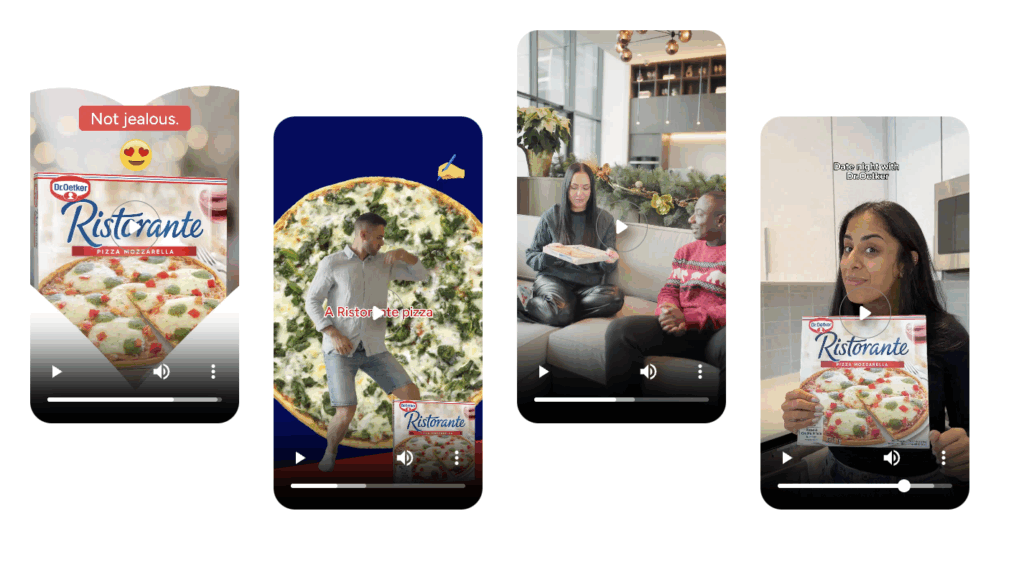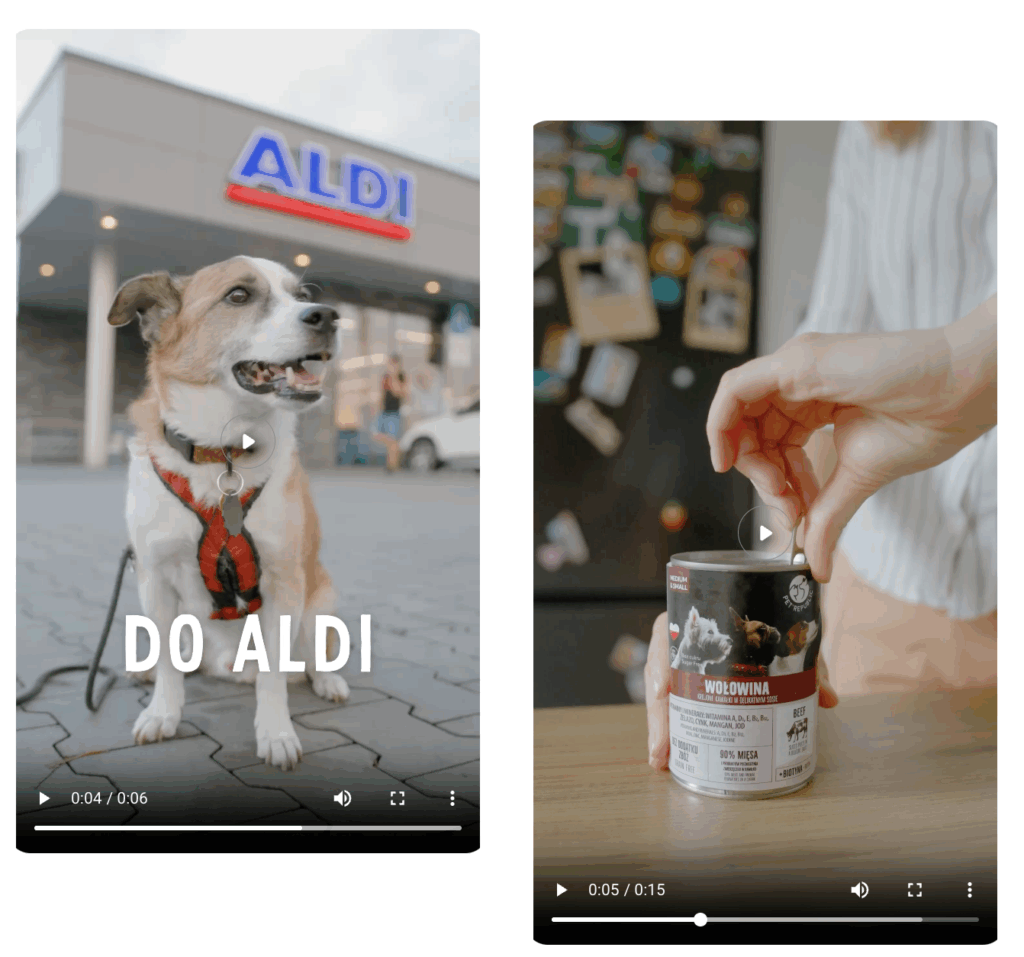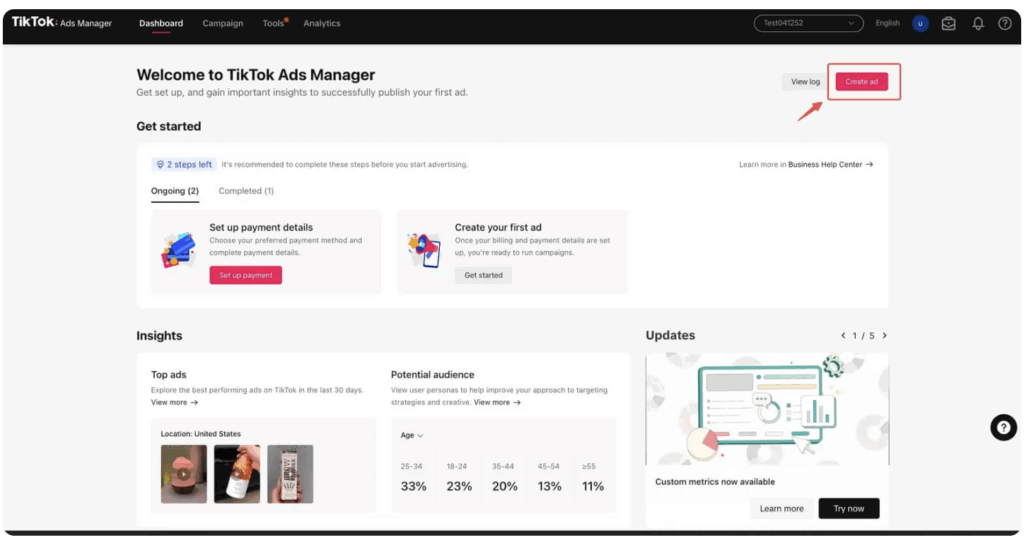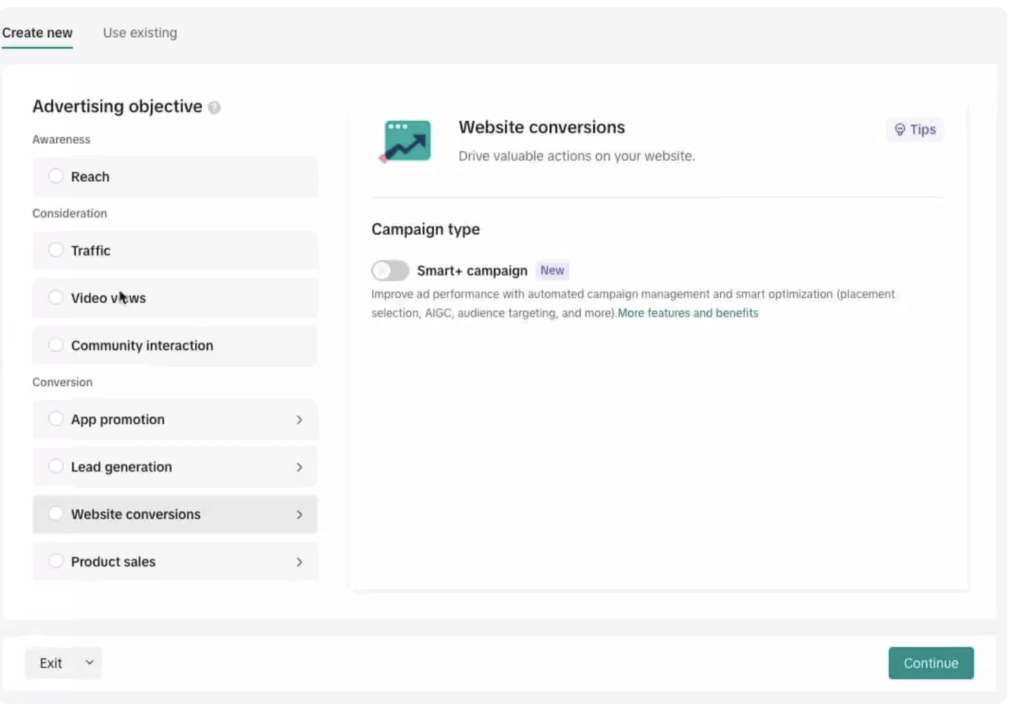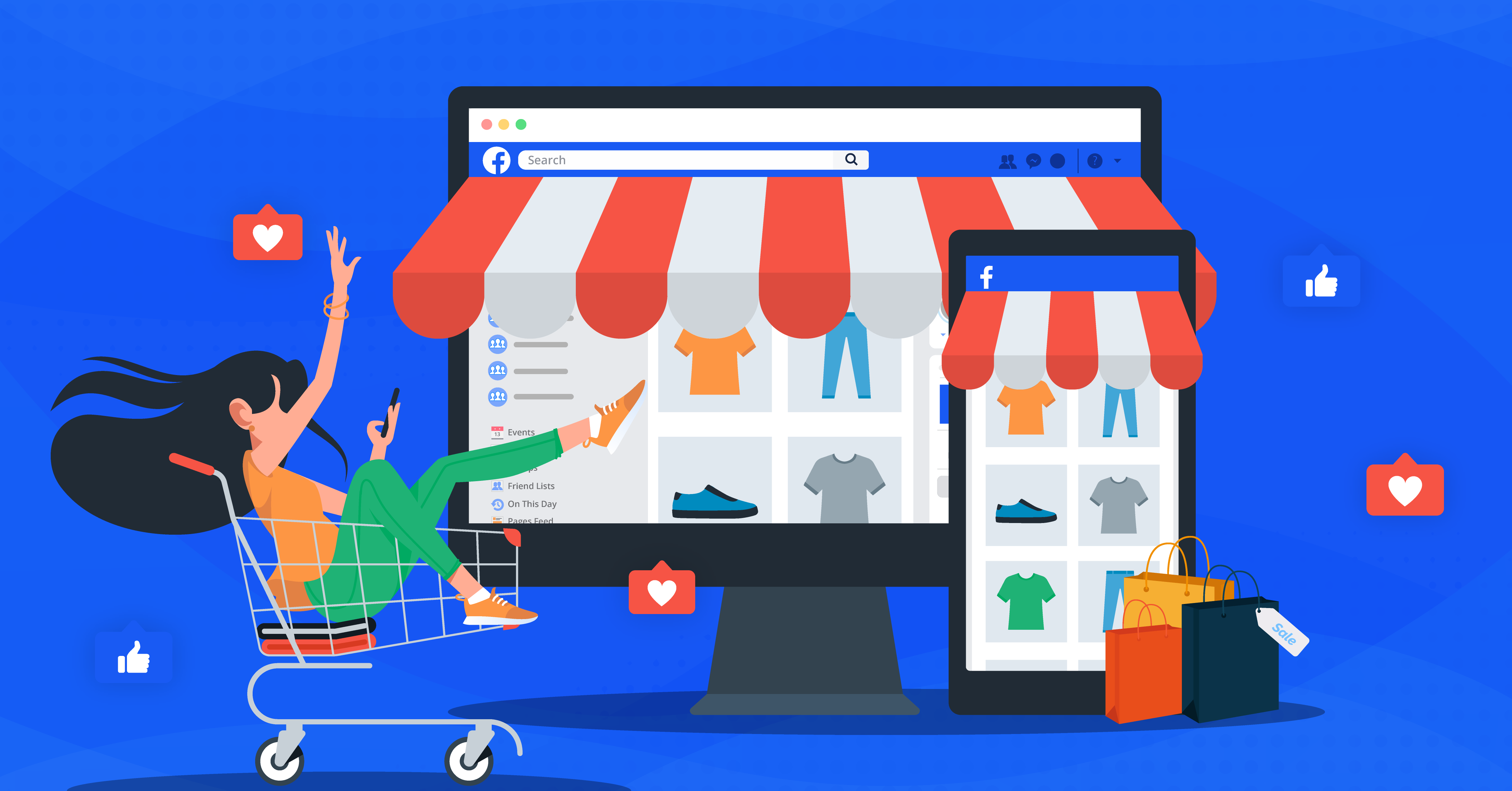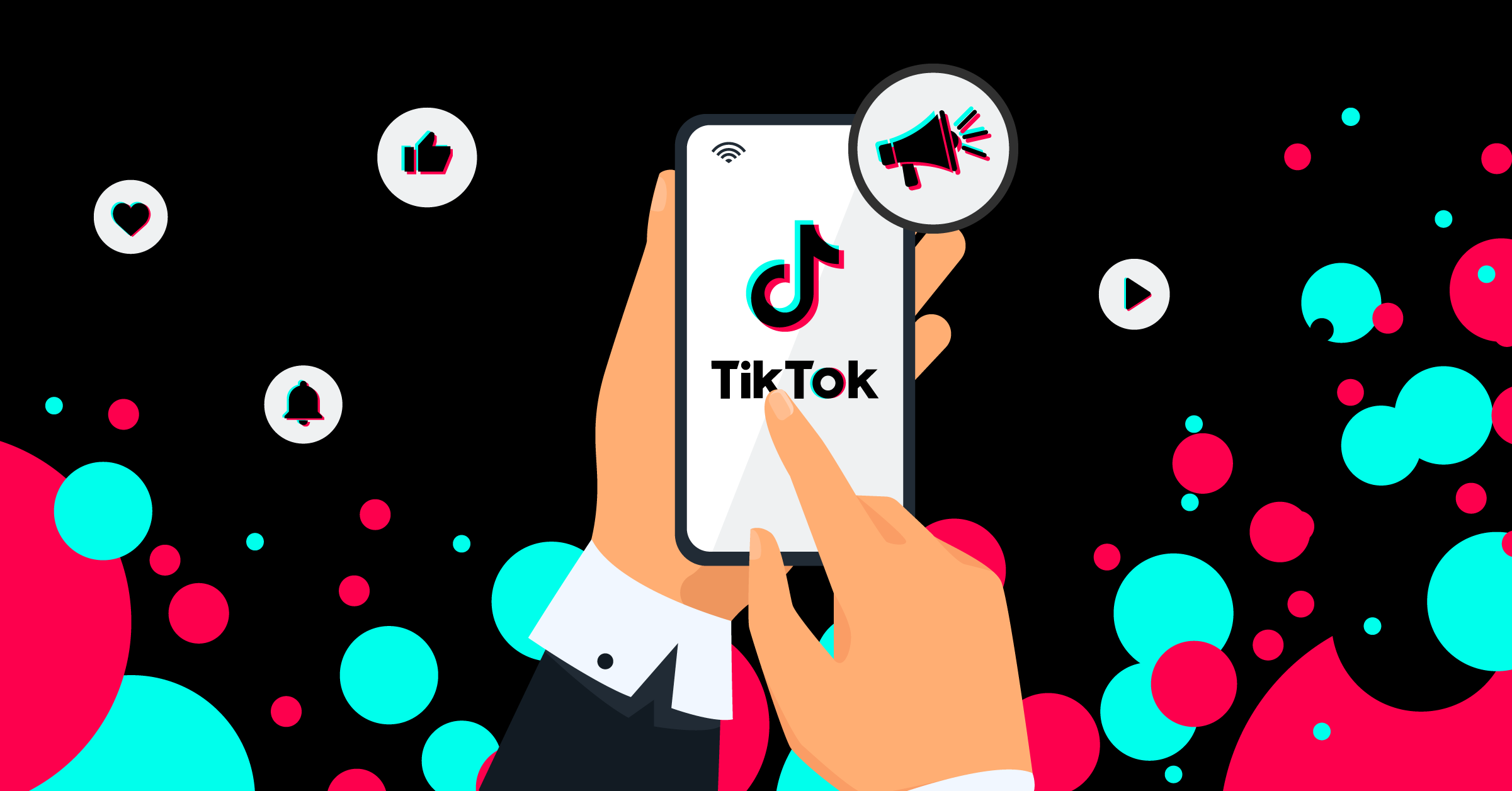
TikTok is a video-sharing social networking service that enables users to make short videos, usually fifteen seconds long, in different genres, such as dance and comedy.
Whether you want to sell more of your products or services or drive targeted traffic to your website, TikTok advertising campaigns can give you good returns on your ad spend.
TikTok launched its lead generation tool to help businesses generate more leads. Wondering how to run ads on TikTok?
- Does TikTok have ads?
- Are TikTok ads for all businesses?
- Why TikTok advertising?
- How effective is TikTok advertising?
- Types of TikTok ads
- The difference between TikTok’s ad placements
- How to run ads on TikTok
- Selecting TikTok’s objectives for your campaign
- TikTok ad targeting
- TikTok ad policy
- Creative Tips at TikTok Ads Creative Center
- TikTok Lead Generation
- TikTok advertising revenue
- How to get ad revenue on TikTok
- How to track TikTok campaigns
- TikTok ads vs. Facebook ads
- TikTok ads vs. Instagram ads
- TikTok ads vs. Google ads
- TikTok ads vs. YouTube ads
- Snapchat ads vs. TikTok ads
- TikTok vs. Pinterest ads
- Takeaways
We have put together this complete guide to show you how to create ads on TikTok, make the most out of it, and boost your ROIs.
In addition, we’ll talk about some of our popular TikTok integrations that you can try for free.
Does TikTok have ads?
TikTok has various ads for businesses to reach their target audience, including In-Feed ads, Brand takeover ads, Top view ads, Branded Hashtag ads, Spark ads, and Branded effect ads. On top of choosing the right formats, understanding the best time to post on TikTok also helps your ads and organic videos get more visibility and engagement.
When creating campaigns and ad groups on this platform, you have the option to set budgets for both. According to TikTok, a campaign can have several ad groups, and there are two types of budgets available: lifetime and daily.
Are TikTok ads for all businesses?
TikTok is suitable for most businesses, but not all. If you are targeting young audiences, you should be running ad campaigns on TikTok now.
Learn more about how to use TikTok for Small Businesses.
Why TikTok advertising?
Most of the TikTok audience is Gen Z. This generation is expected to add nearly $9 trillion in global spending by 2034, surpassing any other generation.
- TikTok has an impressive average engagement rate of 2.5%. Trailing behind, Instagram nabbed second place, but with a significantly lower average engagement rate of just 0.50%.
- Video marketing is on the rise, and TikTok and its users are completely video-centered, making TikTok video ads one of the most effective ways to engage modern audiences. Also, a study found that viewers retain 95% of a message when it is delivered via video.
- The platform offers various TikTok ad formats to improve user engagement. For instance, In-Feed ads enable users to like, comment, share, follow, and shoot video.
- TikTok is available in 154 countries with 75 different languages. If your business operates internationally, TikTok advertising lets you reach audiences in other markets.
Learn more about why you should use TikTok ads here.
How effective is TikTok advertising?
Are TikTok ads truly effective? Simply put, yes. Let’s look at some numbers:
- 92% of TikTok users are inspired to take action upon viewing a video;
- 37% have made purchases based on their discoveries on the platform.
A few years ago, TikTok commissioned four separate Nielsen Media Mix Model Meta Analyses. This experiment revealed that TikTok has a remarkable impact on return on ad spend (ROAS) and sales efficiency in the CPG vertical, for example.
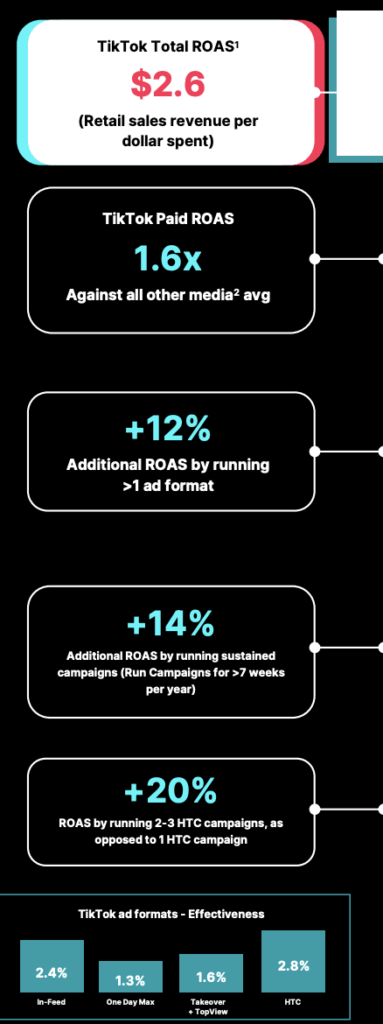
According to these studies, Europe witnessed a staggering 64% higher paid media ROAS compared to all digital media analyzed in the models, along with almost tripled offline sales efficiency. Notably, other regions like the Middle East, US, and Southeast Asia saw similar increases.
According to Kantar LinkAI analysis, over 3,500 measured TikTok ads outperformed their own digital and TV benchmarks by 15-20% across various metrics.
These metrics include:
- Persuasion: how likely an ad influences brand predisposition
- Brand Relevance: the value of communication points
- Enjoyment: the ad’s resonance and application
When viewers enjoy the ads, they become even more effective.
Types of TikTok ads
There are seven different TikTok ad formats for businesses to use, including:
1. TikTok In-Feed ads
TikTok In-feed ads are the video ads displayed inside the native news feed as users scroll through the “For You Page”. They blend well with the TikTok feed.
With In-feed ads, users can like, comment, share, and interact with the TikTok advertising videos.
Here is a good example of a TikTok In-feed ad video.
2. TikTok Brand Takeover ads
TikTok Brand Takeover ads pop up as soon as users open the TikTok app, take over the screen for a few seconds, and then change into an In-feed video ad.
They also appear on the “For You Page” as still images, videos, or gifs with clickable links that lead to landing pages within TikTok.
A great example of a Brand Takeover ad is from Ora, achieving outstanding results such as 713% CTR.
3. TikTok TopView ads
TikTok TopView ads are similar to brand takeovers and aim to increase brand exposure. The difference is that TopView ads do not cover the screen as soon as users sign in.
Instead, they occupy the first In-Feed post after 3 seconds. After that, it shows up to 60 seconds of full-screen video with auto-play and sound.
Below is an example of a TikTok TopView ad:.
4. TikTok branded hashtag ads
The branded hashtags encourage users to record themselves performing something and post it using the defined hashtag. These ads appear at the top of the discovery page.
When users click on the hashtags, it leads them to the landing pages on TikTok and a collection of other videos from the same hashtag challenge. TikTok hashtag challenges boost engagement and brand awareness.
Below is an example of TikTok’s branded hashtag ad from K18 Hair.
They started the #K18HairFlip challenge. Participants in the TikTok challenge stood to win a $1,000 Sephora gift card and a K18 salon service.
5. TikTok Branded effects ads
TikTok branded effects allow businesses to design an ad with their own custom filter on the app. The ad can last up to 10 days at a time and is a great way to increase user engagement.
A good example of TikTok branded effect ads is from Ristorante Pizza.
Colgate created a hashtag challenge #Colgatekiss, to produce an aesthetic for the brand in Thailand. They used a clickable branded effect with a ‘kissy face’ to complement the challenge.
6. TikTok Collection ads
This ad format allows users to find, discover, and browse products on their mobile devices in full-screen mode. When Collection Ads are published, you get to create an ad that will lead to an Instant Gallery Page.
TikTok Collection Ads offer a faster, more engaging ad experience that encourages consumers to take immediate action.

Here’s an example by beauty brand E.L.F., which has made good use of TikTok Collection Ads. With the full screen, their products are at center stage, making it harder for cosmetic lovers to pass them up.
7. TikTok Spark ads
TikTok Spark ads are a native ad format that lets advertisers tap into the power of authenticity by supercharging organic content.
This ad format offers the same amazing user interactions as organic videos: users can comment, like, and share. They can also visit your brand’s profile by swiping left or clicking the handle name or profile picture.
This is made possible thanks to Spark Ads’ unique combination of TopView and In-Feed Ads’ reach and impact.
Looking for inspiration? Here are some high-performing TikTok ad examples.
The difference between TikTok’s ad placements
TikTok ad placements are options that enable businesses to reach their target audience effectively. These placements vary in where the ads appear on the app and how users interact with them. The main TikTok ad placements include:
- Spark Ads: Boosted organic posts from real TikTok accounts, preserving all engagement (likes, comments, shares) as part of your brand’s social proof and format.
- In-Feed ads: Skippable videos (up to 60 sec) shown in the “For You” feed. Users can like, share, or comment.
- TopView ads: Appear when the app is opened, ideal for visibility and awareness.
- Brand Takeover ads: Interactive full-screen ads shown on app launch, available to one brand per day, with clickable elements (e.g., app download, website).
- Branded Hashtag Challenges: UGC-driven campaigns inviting users to create content around a branded hashtag, often with music and effects.
- Branded effects: Custom AR filters or stickers featuring brand elements, designed for user interaction and viral exposure.
- Collection ads: In-Feed ads linked to an instant in-app storefront, enabling users to browse and shop without leaving TikTok.
How to run ads on TikTok
So, how to run ads on TikTok? It is easier than you think.
The TikTok advertising platform, like Meta Ad Manager, automates the ad creation process, including creation, delivery, and optimization. The first step is to install the TikTok pixel on your website.
How to set up a TikTok Ads Account
To advertise on TikTok, you have to create a TikTok Ads Account first.
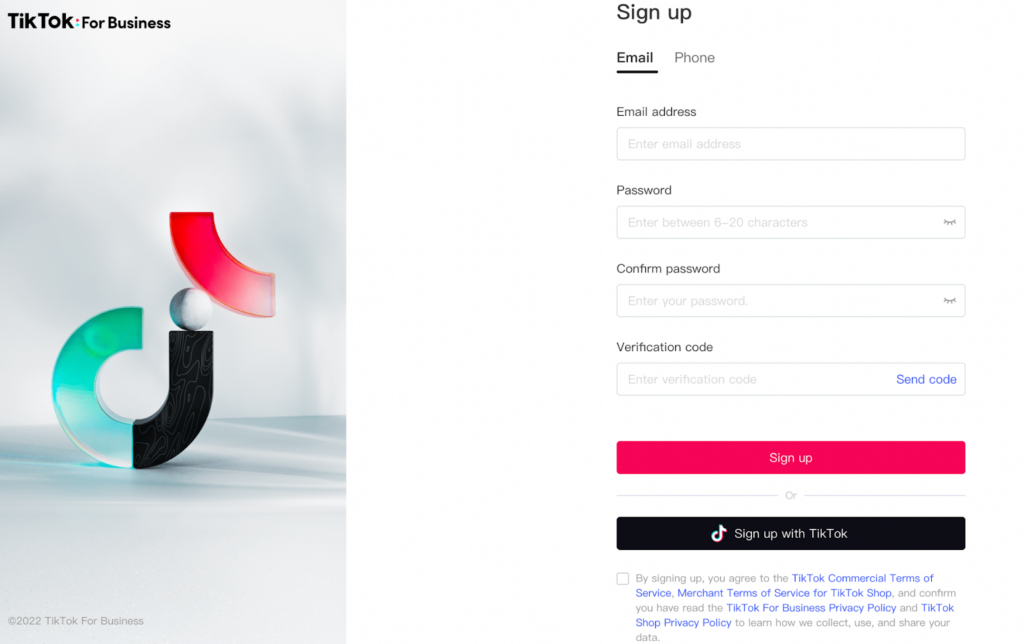
- Add your email address, where you’ll receive a verification code.
- Click Sign up.
- On this new page, fill in the required information, like brand name, industry, country, etc.
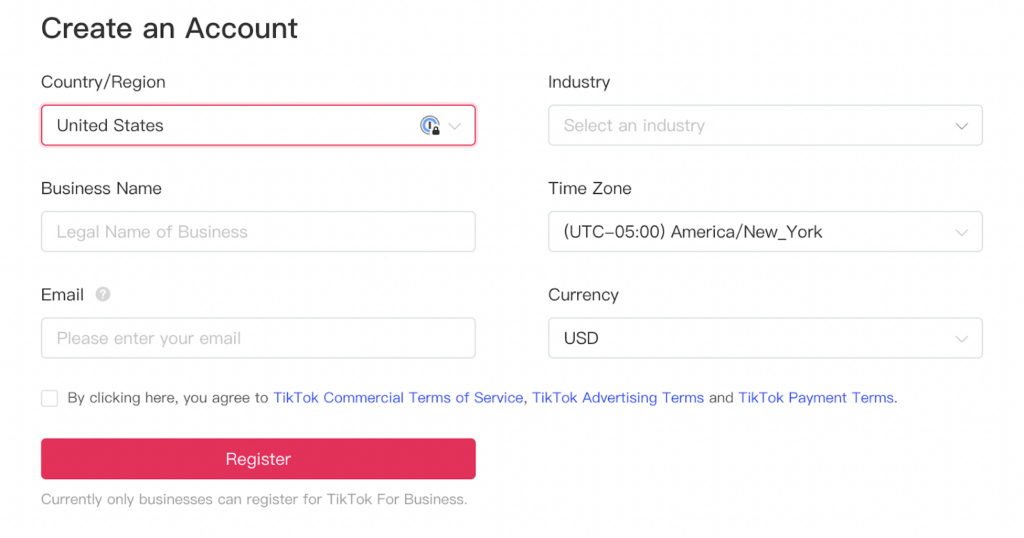
- Then click Register.
If you own a regular TikTok account already, use that account instead to sign up for the TikTok Ads Account.
Learn how to install TikTok Pixel and implement better conversion tracking.
Setting up a TikTok campaign
Now, let’s go through the step-by-step process of creating a TikTok ad.
1. Go to the ad sign-up page and register your business. Provide your business location and select the appropriate account type (business or personal). Then click Next.
2. Fill out your email address and password, ensuring that your password is strong and secure to protect your account, and enter the verification code. Then click to agree to TikTok’s terms and conditions for ads.
That is all you need for now to start setting up your TikTok campaign.

Creating a TikTok ad
Creating a TikTok ad requires three stages. First, create a campaign, an ad group, and then the real ad, with many advertisers also exploring new creative formats.
1. Setting up a campaign
The campaign level is the first step you need to follow to create your TikTok ads. Here, specify the campaign objectives, campaign name, and campaign budget. Your campaign objectives could be app installation, reach, conversions, video views, and traffic.
Here’s what you need to do to set up a TikTok ad campaign:
a. Log in to your TikTok Ads Manager and find the Campaign at the top of the page and click on it.
b. It’s time to choose the objective of your campaign. This signifies the action you want people to take when they see your ads. Accordingly, you must choose the right objective in order to generate the desired result for your campaign.
For instance, if your objective is to generate more traffic to your website, the right objective to choose will be Traffic.
Here are two of our most popular TikTok communication integrations: a marketing system via LeadsBridge to make the most of lead generation efforts on TikTok. A powerful yet simple complement to ad campaigns is to make use of the link in bio TikTok, allowing incoming traffic from organic posts or ads to land on a unified page (your website, product shop, or lead-capture form).
All campaign objectives are categorized into three rubrics—awareness, consideration, and conversion. There is a limit of 999 campaigns per TikTok account.
Now that we are done with the campaign level, the next step is the ad group.
2. Creating an ad group
Under the ad group level, you specify the ad placements, audiences, target audiences, campaign budgets, optimization goals, schedule, and bids for your ad group. The first step to creating the ad group is selecting the placements.
a. Select the ad placements
Ad placement refers to the location where your ad will appear on TikTok. You have the option to choose where TikTok places your ads or let TikTok select the best placement for you.
Leaving ad placement selection to TikTok or using automatic ad placement will help optimize your ad delivery across placements, helping you achieve your specified campaign objective.
The blocklist (pangle) feature is available to advertisers in select countries and is used to block undesired ad placements. Read the block list article to learn more.
b. Choose the desired creatives
The automated creative optimization feature will automatically generate combinations of your creative assets to deliver only the best-performing ones. For example, the campaign’s ad creative assets include images, explainer videos, and ad copy.

c. TikTok ads targeting
At this point, you need to choose the audience you want to target with your campaign. TikTok allows you to create both Custom Audience and Lookalike Audience.
Using TikTok ad targeting, you can target your audience based on their demographics and device preferences to narrow down your audience. This includes age, gender, interest, operating system, location, language, behavior, device price tier, and mobile carrier.
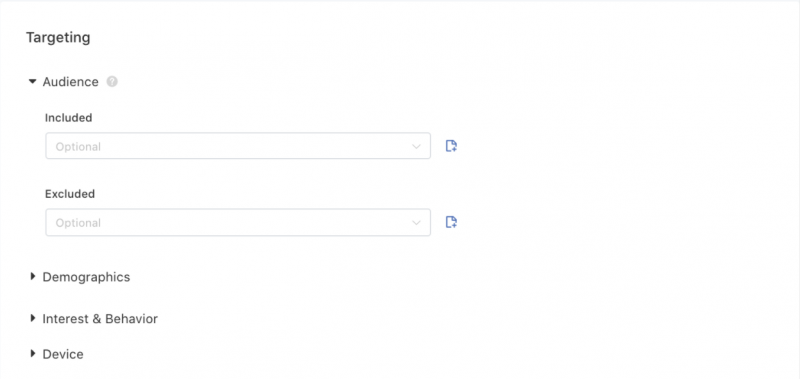
Custom audience targeting on TikTok allows you to target your audiences based on customer data files (a list saved in a CSV, TXT, or ZIP file) and previous interactions with your ads:
- Who has seen your ads before (impressions)
- App activity (e.g., sign up, activate, purchase, etc.)
- Website traffic actions (e.g., view content, button click, purchase, form submission, etc).
Similar to Meta’s custom audiences, TikTok Custom Audiences enable you to target individuals who have interacted with your business.
The most interesting part is that you can integrate TikTok custom audiences with different tools through LeadsBridge to automate the entire data management process.
d. Set the budget and the schedule
In this section, specify your ad budget. There are different options here, as shown below.
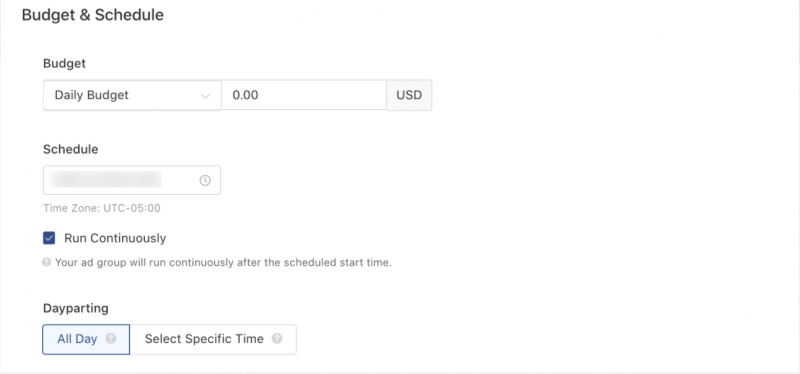
Now is the time to set a budget for the ad. This can be a daily budget or a lifetime budget. The schedule specifies the start and end times for the ads.
Choose a range of dates to run your ad, or opt to run it continuously for as long as you want. The day-parting option lets you choose specific time periods throughout the day, ranging from half an hour to 24 hours.
e. Set up the bidding and optimization
This is the section where you choose your bidding process and optimization options and add third-party tracking links to help monitor the performance of your ad.
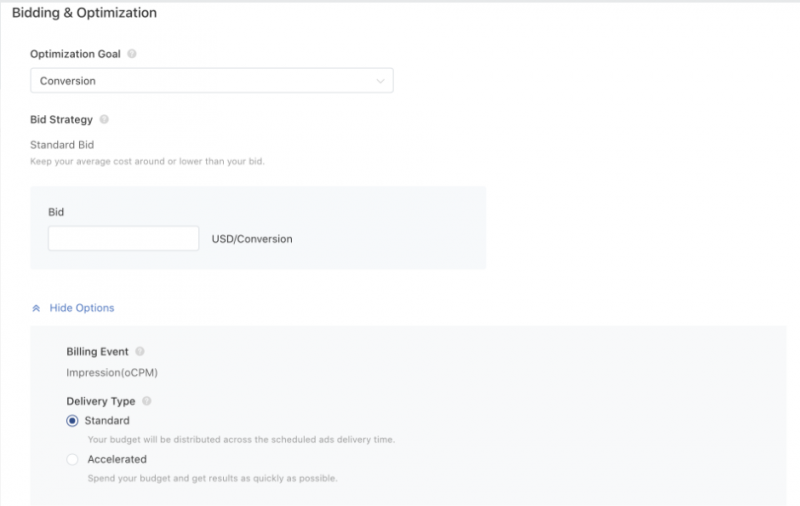
The first option here is the optimization goal. There are three types: conversion, click, and reach.
First, choose the goal for your campaign, then configure the billing event option. The TikTok system automatically sets the billing event based on your selected optimization goal.
Here’s a link to more information on bidding methods on the TikTok Ads Manager.
Next comes smart optimization. This option allows you to choose how the system optimizes conversion events and carries out smart delivery. It is recommended that you activate the smart optimization option to help with your conversions.
The bid strategy helps control your cost per result when set to “standard bid” mode. This ensures the average cost per result stays within your bid during delivery.
The bidding option helps you set the amount you are ready to pay for a thousand impressions, per click, or per conversion. The TikTok system will deliver the ads as per your bid specification.
The delivery type is available in two formats: standard and accelerated. When you select the standard delivery, your ad budget will be spent evenly during the campaign. The “accelerate delivery” option will spend the budget quickly during the campaign.
You can find more information on the delivery type here.
Now it is time for the exciting part: creating your ad.
3. Creating your ad
Ad creation on TikTok is easy. All you need to do is upload your images or videos and eye-catching design ads in minutes using the features available on the TikTok ad manager.
Now, follow the steps below to create your TikTok ad.
a. Start by entering the ad name in the specified field below. This will help you identify your ads.

b. Choose the ad format.
- Image Ads (single image) are supported in Ads Manager.
- Carousel Ads let you swipe through multiple images directly in-Feed. TikTok bills them as an alternative when you don’t have a video.
- Shopping/Product ads can pull product images from your TikTok Shop catalog (GMV Max campaigns).
c. Add your ad details by uploading your creative media. You can upload your media from your computer or use the media from your previous ads. You can also choose to create a new video.
To create a new video, select “use video template” or “smart video“. Select the video thumbnail that will serve as a cover photo for your video ad. You can upload a new one or choose from the images in your video.

Include the text and link that will be shown with your ad. This includes the display name, text, call to action, profile image, and the URL of the website you want to drive traffic to if traffic is your main campaign objective. When you are done, preview your ad on your device. This will show you how the video ad will look after publishing it.
d. Add relevant tracking links to your ad.
TikTok lets you add third-party tracking URLs and Pixels to track your ad performance. Here is a list of supported third-party measurements and TikTok Pixels.
Click the “submit” button to complete the ad creation process when you are done. This will trigger the ad review process. Once your ad is approved, it will automatically go live.
Selecting TikTok’s objectives for your campaign
TikTok objectives are divided into three categories: Awareness, Consideration, and Conversion.
Awareness
The Awareness category includes the Reach objective, which serves video ads to the largest possible audience on TikTok.
This objective is ideal for advertisers looking to increase brand awareness and expand their reach on the platform.
Consideration
The Consideration category offers several objectives to help advertisers drive specific actions and engagement from users.
Here’s what falls under this category:
- Traffic: Send people to a site or app page.
- Video Views: Optimize for watch-throughs.
- Lead Generation: Capture leads with Instant Forms or your own form as well as Pixel and SDK.
- Community Interaction: Drive follows, profile visits, or page visits to build on-platform momentum.
- App Promotion: Acquire new users (installs) and re-engage lapsed ones.
Once you collect enough data at this stage, you’ll need to process it efficiently.
LeadsBridge automatically sends lead data generated from your TikTok Lead Ad campaigns to your CRM or marketing automation platform. This helps you to follow up with leads on time, which could improve your conversion rate.
Conversion
The Conversion category is focused on driving specific user actions on the advertiser’s website, such as page views or online sales. The Conversion objective helps advertisers to optimize their campaigns toward achieving these specific goals.
With LeadsBridge, you can connect your CRM or marketing platform with TikTok Conversions to track your segmented audiences and monitor conversions for a full-funnel measurement.
TikTok campaign objectives vs. TikTok advertising objectives
TikTok’s advertising objectives and campaign objectives are both important components of a successful TikTok ad campaign. While the two terms are sometimes used interchangeably, they have different meanings and functions.
You can differentiate the two with a simple definition:
- Advertising objectives are your specific business goals (e.g., increase brand recognition, drive traffic, get installs, grow views, collect leads).
- Campaign objectives are the setting you choose in Ads Manager to make that goal happen (Reach, Traffic, Video Views, Lead Gen, Community Interaction, App Promotion, Sales).
It’s essential that you keep them aligned. This means one clear KPI, matching the campaign objective with that KPI, and adjusting your optimization event throughout.
TikTok ad targeting
TikTok ad targeting dimensions are parameters advertisers use to reach specific audiences on the platform. Here are standard TikTok ad targeting dimensions:
- Demographics: Age, gender, location, language, and spending power/household income (availability varies by market).
- Interests and behaviors: Hobbies, topics, industry interests, and past ad or content interactions.
- Device and connection type: Device model, operating system, and connection type (Wi-Fi or mobile data).
- Custom audiences: Use your own data (e.g., email lists, website/app visitors) to retarget users. TikTok’s server-side Events API strengthens this by capturing more reliable event data.
- Lookalike audiences: Reach new users who share traits with your existing audience.
Why audience targeting matters on TikTok
Targeting focuses delivery on people most likely to be interested, boosting engagement and conversions. This is why reaching the right audience minimizes waste and improves ROI.
Relevant targeting also drives higher CTRs, conversions, and overall campaign performance.
Based on that, you can send tailored messaging to increase the impact of your campaign and improve the user experience.
TikTok ad policy
TikTok’s ad policy sets clear rules to keep ads safe, relevant, and follow community standards.
It covers ad formats, creative specs, and targeting practices, and prohibits misinformation, tobacco/nicotine, weapons, and paid political ads.
Advertisers must follow creative and format guidelines (e.g., no fake UI buttons, consistent landing pages) to maintain a user-friendly experience. Staying compliant protects your brand and improves approval rates and performance.
Here are some important highlights for marketers.
Use the right ad format
Ads must clearly reflect what’s being promoted. Landing pages must match the ad and be fully functional with no bait-and-switch.
All messaging, visuals, and language must be relevant, accurate, and appropriate for the target audience.
TikTok Ad Specs
- Aspect Ratio: 9:16 (preferred), 1:1, or 16:9.
- Resolution: Minimum 540×960; 720×1280+ recommended.
- Formats: .mp4, .mov, .mpeg, .3gp, .avi.
- Video Duration: Non-Spark up to 10 minutes; Spark Ads inherit the original post (no set limit in specs).
- Max File Size: ≤500 MB.
- Profile Image: Square 1:1 (98×98 px), ≤50 KB.
- Brand/App Name: Brands 2–20 characters; Apps 4–40 (varies by language).
- Ad Description/Captions: For Non-Spark, captions show in a uniform font and don’t support clickable links, @, or hashtags. Spark Ads use the original post caption and may include emojis; they display truncations after a few lines.
Spark Ads Specs
Flexible on aspect ratio, resolution, and length because Spark promotes an existing post. Media is inherited from the original.
Original post display name, text, emojis, and mentions are allowed (as per the source post).
Note: Character limits differ by language (e.g., Asian characters may count differently). Keep key info early to avoid truncation.
Creative Tips at TikTok Ads Creative Center
TikTok Ads Creative Center is a free resource with guidance and inspiration. You can browse without a Business Account, though logging in gives deeper insights.
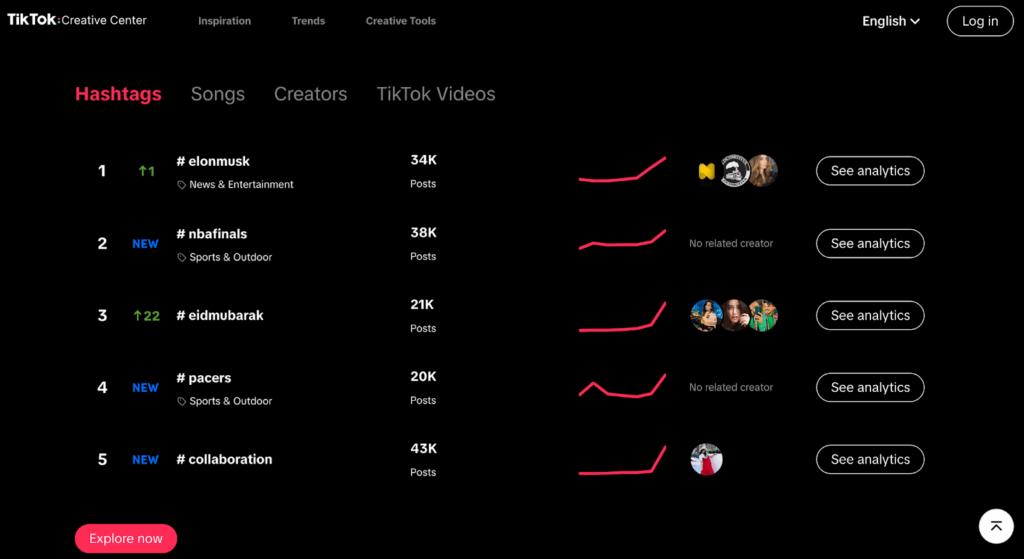
It’s useful because it provides:
- Best practices for building better-performing TikTok ads.
- Up-to-date insights on trends across industries.
Use Top Ads to see high-performing ads in your category: Filter by campaign objective to find examples that match your goals.
Use Trend Discovery to track what’s trending (hashtags, songs, creators, videos), then apply those insights to your creative tests and strategy.
TikTok Lead Generation
Similar to Facebook lead ads, TikTok Lead Generation uses a pre-filled form with the user’s name, email, phone number, and other requested details
Brands can use the TikTok Lead Generation to reach and engage with their prospects and customers and collect their data directly on in-stream ads on TikTok. You have a higher chance of conversions if your profile has likes and a high number of views.

TikTok Lead Generation forms are built for mobile and keep users on the platform. The form includes a customizable background image (great for branding), your profile image, and a question section you can tailor to collect the info you need.
As an official TikTok partner, LeadsBridge offers integrations with TikTok Lead Generation that facilitate seamless and automated data management.
Automated data bridges help connect your TikTok lead ads with your favorite tools, such as Salesforce®, Google Sheets, Klaviyo, etc.
Another great feature is TikTok Custom Audiences, which was designed to perform as a TikTok targeting option. Besides building audience segments, it enables you to connect with individuals who have previously engaged using:
- Interest Targeting: Reaches users based on their personal interests and the content or brands they engage with.
- Behavioral Targeting: Targets users based on how they interact with your brand over time.
- Retargeting: Re-engages users who have already interacted with your content or ads.
- Demographic Targeting: Targets audiences by age, gender, location, language, and other characteristics.
You can upgrade your TikTok advertising by integrating TikTok Custom Audience with your favorite marketing tool.
TikTok advertising revenue
TikTok stays a high-efficiency reach machine for mobile-first audiences, and TikTok Shop keeps tightening the loop from discovery to purchase.
- Ad revenue: About $26.4B (2024) to over $32B (2025, trajectory).
- Share of social ad spend: TikTok + Douyin about 11% by 2026 (scenario-based).
- Long-term potential: Directional forecasts land near $54B by 2027.
- U.S. outlook: About $14B in 2025 despite regulatory headwinds.
Policy watch: Divest-or-ban law is yet to be upheld. Enforcement is currently delayed to Dec 16, 2025.
How to get ad revenue on TikTok
If you’re interested in how to get ad revenue on TikTok, you can follow these strategies:
- Make native creatives: Shoot UGC-style, hook in the first 2 seconds, clear offer, strong CTA. Kill weak variants fast; keep testing.
- Use trends: Use relevant hashtags/tracks (via Creative Center), but only when they fit your product/story.
- Use Ads Manager for outcomes: Run the Sales objective with Pixel/Events API for purchase optimization. Start broad; let delivery learn.
- Lean into commerce: If available, use TikTok Shop/Product Ads (GMV Max) to cut friction and convert in-app.
- Partner with creators: Source through Creator Marketplace. Spark Ads whitelisting lets you run from the creator’s post for higher trust.
- Optimize for mobile speed: Match ad-to-landing page, fast load, clean checkout. In-app shopping beats slow sites.
- Length: Short often wins (15–30s), but clarity beats brevity. Demo formats can run longer if they hold attention.
How to track TikTok campaigns
TikTok Ads Manager offers a comprehensive dashboard where you can monitor ad performance, spend, and delivery status across campaigns, ad groups, and individual ads.
You can track key metrics like CPM, CPC, CPA, CTR, and conversions, and filter results by audience data such as gender, device type, and time of day.
TikTok also offers customizable report templates that make it easy to build detailed performance reports. You can download them on demand or schedule automatic delivery. It can be daily, weekly, or monthly. TikTok server-side tracking helps strengthen this by capturing more accurate event data for these audiences.
To access the data, navigate to the Campaign page, select the campaign, ad group, or use ad tags, and then click “View Data” to view performance metrics and audience insights.
TikTok ads vs. Facebook ads
TikTok and Facebook remain top choices for digital advertisers, but they serve different strengths. .
Facebook still leads in detailed targeting, diverse ad formats, and full-funnel marketing across both Facebook and Instagram.
The right platform depends on your campaign goals, creative style, and target demographic.
| Feature | TikTok ads | Facebook ads (Meta) |
| Content Style | Short-form, video-first, music-driven | Mixed content (video, image, carousel) |
| Best For | Engagement, virality, younger audiences | Targeting depth, lead gen, retargeting |
| User Base | 2B+ MAUs, mostly Gen Z & Millennials | 3B+ MAUs, broader age range |
| Ad Formats | In-Feed, TopView, Spark ads, Branded effects | Video, Image, Carousel, Instant Experience |
| Creative Approach | Trend-driven, native-feel, UGC-style | Structured, CTA-driven, varied formats |
| Targeting | Interest, behavior, lookalikes | Demographics, behaviors, custom audiences |
| Analytics | TikTok Ads Manager, real-time trends | Meta Ads Manager, detailed reporting |
| Average CPM | ~$3–10 (2025) | ~$8–14 (2025) |
| Average CTR | ~0.7–1.5% (higher for TopView) | ~0.9–2% depending on format |
Learn all about TikTok ads vs. Facebook ads here.
TikTok ads vs. Instagram ads
TikTok and Instagram are both powerful visual platforms, but they serve slightly different purposes. Instagram ads stand out due to their advanced targeting and a more established ad ecosystem.
Your platform choice should match your audience and brand. Here’s what to look for:
| Feature | TikTok ads | Instagram ads |
| Content Style | Short-form, full-screen video | Photos, Stories, Reels, carousels |
| Best For | Virality, Gen Z engagement | Brand polish, broad reach, retargeting |
| User Base | 2B+ MAUs, mostly Gen Z | 2.5B+ MAUs, strong Millennial and Gen Z mix |
| Ad Formats | In-Feed, Spark Ads, TopView, Branded Effects | Feed ads, Reels, Stories, Carousels |
| Engagement Rate | Higher (especially for UGC + creators) | Moderate, varies by format |
| Targeting | Interest, behavior, lookalikes | Advanced: interest, behavior, retargeting |
| Analytics | TikTok Ads Manager | Meta Ads Manager (Instagram via Facebook) |
| Average CPM | ~$3–10 (2025) | ~$7–12 (2025) |
| Average CTR | ~0.7–1.5% | ~0.9–2% |
Take a look at some of our popular Instagram integrations:
TikTok ads vs. Google ads
TikTok ads are ideal for engaging younger audiences (Gen Z and Millennials) through visually creative videos. Google advertising is built for intent-based marketing.
The strongest strategies in 2025 often combine both platforms: TikTok for discovery, Google for intent.
Here’s how they compare:
| Feature | TikTok ads | Google ads |
| Primary Strength | Engagement, awareness, and cultural relevance | Intent-driven targeting, conversions |
| Best For | Gen Z & Millennials, viral reach | High-intent users ready to act |
| Content Style | Short-form, creator-led, trend-driven | Text search, display banners, product listings, video |
| Ad Formats | In-Feed, TopView, Spark, Hashtag Challenges | Search, Display, Shopping, YouTube (Video) |
| Audience Targeting | Interest, behavior, lookalikes | Keyword, demographic, remarketing, custom intent |
| Engagement Style | Scroll-based discovery, entertainment-first | Action-based search, direct navigation |
| Average CPC (2025) | ~$0.50–$2.00 | Varies widely (~$1–$10+ depending on competition) |
| Conversion Strength | Low to mid-funnel | Mid to bottom-funnel |
Check out these integrations that help you leverage your Google lead generation:
TikTok ads vs. YouTube ads
TikTok is built for trend-driven content with a strong emphasis on creativity and viral potential.
YouTube supports both short- and long-form content, with deeper viewer intent and longer attention spans. It’s better suited for storytelling.
The choice very much depends on how you want your message consumed.
| Feature | TikTok ads | YouTube ads |
| Content Style | Short-form, vertical, sound-on | Short- and long-form, horizontal or vertical |
| User Intent | Discovery, entertainment | Active watching, intentional search |
| Top Ad Formats | In-Feed, Spark ads, TopView, Branded Challenges | Skippable/Non-skippable Video, Bumper, Shorts |
| Best For | Awareness, engagement, trend participation | Education, deep storytelling, high-retention ads |
| User Base (2025) | 2B+ MAUs, Gen Z & Millennials | 2.7B+ MAUs, across all age groups |
| Engagement Style | Fast, scroll-based, community-driven | Longer view sessions, more deliberate attention |
| Targeting Options | Interests, behaviors, lookalikes | Keywords, demographics, in-market, custom intent |
| Avg CPM (2025) | ~$3–10 | ~$5–15 |
| Avg CTR (2025) | ~0.7–1.5% | ~1–2.5% |
Take a look at some of our popular integrations:
Snapchat ads vs. TikTok ads
Both Snapchat and TikTok are strong platforms for reaching Gen Z and younger millennials. Snapchat mostly focuses on private sharing and immersive ad formats like AR Lenses, Filters, and Stories.
You should take your pick based on important markers of both platforms:
| Feature | TikTok ads | Snapchat ads |
| Content Focus | Short-form, trend-based video | Private, immersive, and AR-driven content |
| User Base (2025) | 2B+ MAUs, mostly Gen Z & young millennials | 750M+ MAUs, strong among ages 18–34 |
| Top Ad Formats | In-Feed, TopView, Spark ads, Hashtag Challenges | Snap Ads, Story Ads, Lenses, Filters, Collection Ads |
| Creative Strength | Viral, sound-on, creator-driven content | AR, sequential storytelling, interactive formats |
| Targeting Options | Interests, behaviors, lookalikes, retargeting | Demographics, behaviors, custom audiences |
| Engagement Style | Public, trend-based discovery | Direct, 1:1 or group-based interaction |
| Best Use Case | Brand awareness, cultural engagement, UGC | Product try-ons, location-based or AR campaigns |
| Avg CPM (2025) | ~$3–10 | ~$3–8 |
| Avg CTR (2025) | ~0.7–1.5% | ~0.6–1.2% |
Check out these integrations to automate your campaigns’ data management:
TikTok vs. Pinterest ads
Pinterest is intent-focused, mostly used for planning and inspiration.
Choosing between them depends on your campaign goals: TikTok is best for cultural impact and virality, while Pinterest excels at influencing purchase decisions and long-term planning.
| Feature | TikTok ads | Pinterest ads |
| Content Focus | Entertainment, trends, short-form video | Inspiration, planning, and evergreen content |
| User Intent | Passive browsing, entertainment | Active searching, high purchase intent |
| Top Ad Formats | In-Feed, Spark Ads, TopView, Hashtag Challenges | Promoted Pins, Idea Ads, Shopping, Carousel |
| User Demographic | Mostly Gen Z & Millennials | Broad age range, strong female audience |
| Engagement Style | Trend-driven, creator-led, fast-paced | Visual discovery, slower-paced, save-first |
| Best For | Awareness, engagement, UGC | Product discovery, planning, and purchase intent |
| Targeting Options | Interest, behavior, lookalikes | Keywords, interests, custom, act-alike audiences |
| Avg CPM (2025) | ~$3–10 | ~$2–5 |
| Avg CTR (2025) | ~0.7–1.5% | ~0.9–2.2% |
Here are some helpful resources to help you learn more about Pinterest ads:
Takeaways
TikTok is a leading ad platform for brands targeting global, mobile-first, and younger audiences. Its high engagement and mobile-optimized lead generation tools allow marketers to collect user data directly through in-stream ads.
For best results, your incoming leads should be synced for further nurturing via automated integrations.
Discover our TikTok Lead Generation integrations and join the TikTok Custom Audience waiting list to take full advantage of your TikTok advertising campaigns.





